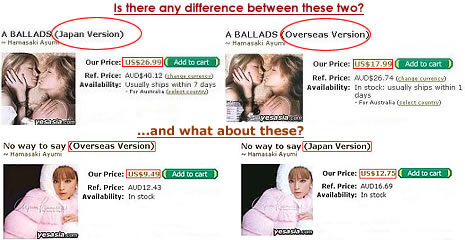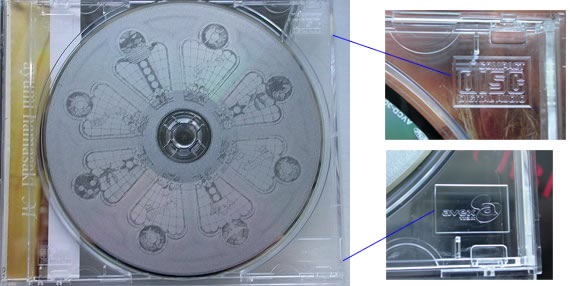
|
Other
important issues:
|
|
General notes
|
|
|
There have been many
discussions on different forums. With inconclusive results, I might
add... To illustrate the question, let's have a look here:
|
|
 |
|
| That's what is written on
YesAsia.com Internet site: "An original version refers to a product that is imported from the country it was produced and released. Therefore the price is slightly higher than the overseas version. An overseas version refers to a product that is released by a licensed local record label and therefore the price is more competitive to the local market. Other than the price difference, the overseas version may also include some slight changes, such as, the translation of the booklet into local language, different packaging and printing, or the inclusion of additional bonus tracks." |
|
|
So, you may think that that's the end of the issue... Far from it. I don't have different versions of the same CD, so the following might or might not be correct: |
|
|
1
|
TRUE - The price is different. An "Overseas" version will cost less than a "Japan" one. |
|
2
|
TRUE - Releases may be different. The number of tracks, their order etc. are the same - so, basically, if you are only 'after music' - there is no difference. However, the packaging would be slightly different (accounting for the fact that an "Overseas version" is mainly oriented for the Chinese-speaking audience). There would be an extra card for the CD side (obi) in Chinese and a small extra booklet with translation of the songs' lyrics (usually without any pictures and into Chinese, naturally...). Video CDs may have Chinese subtitles that cannot be switched 'on' or 'off' (English subtitles appear to be a myth - to the best of my knowledge they do not exist, at least - not on official releases). If you know neither Japanese, nor Chinese - these booklets and subtitles are useless. If, on the other hand, you do read/speak Chinese you would find the "Overseas version" more desirable to have. A note: English 'reference cards' that serve the same purpose as small booklets in Chinese are available in the discography section of the site for all albums. |
|
3
|
TRUE - DVDs are issued for different zones. "Japan" version are for Region 2 (Japan, Europe, South Africa, Middle East), "Overseas" versions - for Region 3 (South-East Asia, East Asia, Hong Kong). So, if you live in Region 1 (USA, for example) or Region 4 (that's here, in Australia) - you will not be able to watch either version. Unless you have a 'region-free' DVD player, of course. |
|
4
|
LIKELY - Quality of booklets is better on "Japan" version. Some people say it's the case. I'd say this is more for perfectionists - it is not very much important for me if the booklet of the CD I have is printed on really glossy paper or not. The quality of printing makes a significant difference for things like a large book of, say, reproductions of paintings or prints - not for 12x12 cm booklets... It's the music on the CD I am paying for, not the nice wrapping of it. Though other people may (and will) have a different opinion. |
|
5
|
UNLIKELY - Quality of sound is better on "Japan version". There are different opinions on the subject - some people say that they can hear the difference, others - that there isn't any... Maybe if one has a 'top level' audio system (for ~ $2,000+, with matching $500 headphones) and can, therefore, listen to music without being interrupted by any outside noise - one could hear that difference. I would not know... The only definite (and significant) difference is between normal audio CD and a DVD-audio one - as described on this page. |
| Let's take a look on the CD case... |
 |
| Basically, there is an avex logo printed on the plastic of the CD case. On 'overseas' releases and bootlegs only "compact disc digital audio" label in present; the place of the avex logo is blank. |
| Very useful information by Lady Ryouji from AYUNITE! forum: |
| 1. Booklet and presentation of 'Japan'
and 'Overseas' versions a) The colors are different - both on the cover and on the CD, b) The paper that contains Ayumi name and the avex trax logo (which covers the sides of the box) differ in quality (more rigid paper in a 'Japan' version), c) The guality of the booklet is better in 'Japan' version. |
| 2. About "LOVEppears" double
CD a) 'Overseas' version may not contain the booklet with pictures, only a booklet with lyrics and the information on the second CD [Nick's note - my 'Overseas' version has the booklet with pictures, so I guess 'Overseas' versions may also differ between themselves...]. b) The poster in 'Overseas' version is folded 3 times (consists of 8 squares) and is a separate insert that is blank at the back. In the 'Japan' version the poster is a part of the booklet and is only folded once [Nick's note - I guess it is smaller in size, too, then...] |
| 3. About "A Song For XX"
album 'Japan' version has a great presentation, and the CD case is bigger than the standard one (the booklet is so well made and the paper is so good that it occupies more space - so it needs a bigger box). 'Overseas' version comes in the standard case [Nick's note - that is correct, my 'Overseas' version is in the usual CD case]. |
| 4. About "A Best" album 'Overseas' version has a rigid 'slipcase' to hold the standard CD case inside, the usual 'Japan' version appears not to have it (only the 'Japan - Limited Edition' one). [Nick's note - I have to agree that this is the situation where an 'Overseas' version is probably better than the 'Japan' one]. |
 |
||||
